

![]()
![]()
This Page:
Arkansas Building: Jean Loughborough, architect
Pennsylvania Building Murals (Dodson, Rongier, Bush-Brown, Clements)
Illinois Building: Friezes (Fay, Means, Lusk, Dohn, Burgess, Kellogg,et al)
Architectural Statuary in State Buildings (Illinois, Indiana, Wisconsin)
![]()
![]()
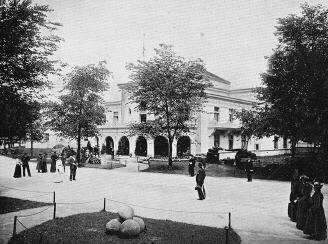
The Arkansas Building, designed by Jean Loughborough,
was Renaissance style, 60 x 85 feet. It had a central
court (30 ft sq) with fountain and a glass cupola over it.
![]()
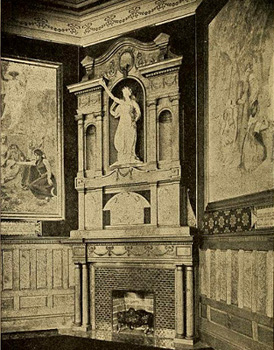
Dodson's mural Pax Patriae on left;
Clements' mural Harvest on right.
(See images below.) Reception
Room, Pennsylvania State Building,
1893 Exposition.
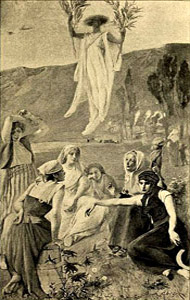
Pax Patriae--Sarah
Paxton Dodson's wall
mural in Pennsylvania
State Building, 1893
Exposition
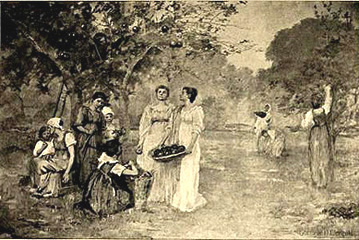
Harvest--Gabrielle de Veaux Clements' wall mural,
Pennsylvania State Building, 1893 Exposition.

Rongier's murals Reverie and Maternity on the left
and center-left, respectively, of the photo;
Bush-Brown's mural Spring on the right. (See images
below.) Reception Room, Pennsylvania State Building,
1893 Exposition.

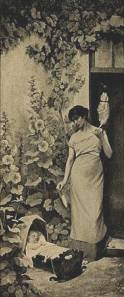
Reverie (left)
and Maternity (right)--
Jeanne Rongier's murals in the
Pennsylvania State Building,
1893 Exposition.

Spring-- Margaret Lesley Bush-Brown's
mural in the Pennsylvania State
Building, 1893 Exposition.
According to one source, "In the salon or reception rooms are several mural paintings, all of them executed by prominent artists. A panel by Mrs. Bush-Brown shows a group of young girls dancing on the sward beneath the boughs of an apple tree, covered with the delicate blossoms of spring. On another panel Mrs. Clements depictures the mellow fruit, with peasants about to gather the fruitage of the year. In one of the two panels by Jane Rongier, poetic or intellectual life is symbolized in the form of a young girl wandering, book in hand, adown a forest path, her features reflecting the thoughts suggested by some inspiring passage. On the other panel, entitled "Serious or Family Life" [titled "Maternity" above], a young mother stands at the threshold of her cottage, spinning from the distaff, her eyes fixed lovingly on the cradle in which her babe is sleeping. A fifth panel by Sarah P. Dodson represents a number of female peasants resting in the harvest field toward set of sun, and grouped around an aged woman, to whose words they listen eagerly" (source).
More information on Margaret Leslie Bush-Brown.
More information on Sarah P. Dodson.
More information on Gabrielle de Veaux Clements.
More information on Jeanne Rongier.
![]()
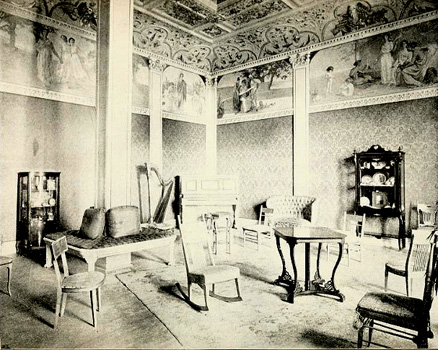
Frieze art in the Reception Room, Illinois State Building, 1893 Exposition.
Fay's The Drama on center-left; Kellogg's frieze Instruction
on center-right; Dohn's frieze Industrial Arts on far right.
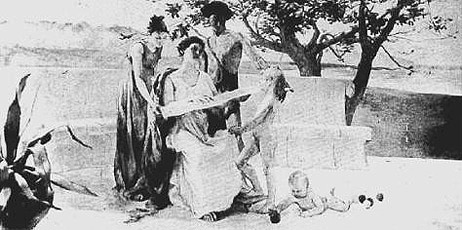
Alice D. Kellogg, Instruction.
Reception Room, Illinois State Building, 1893 Exposition.
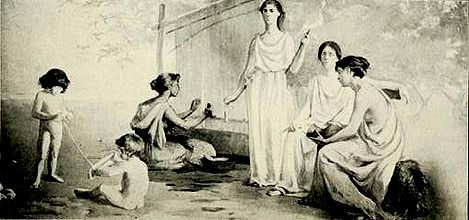
Pauline A. Dohn, Industrial Arts.
Reception Room, Illinois State Building, 1893 Exposition.
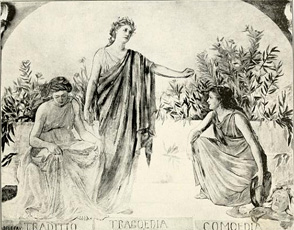
Adele Fay, The Drama.
Reception Room, Illinois State
Building, 1893 Exposition.

Mary W. Means, Dancers.
Reception Room, Illinois State
Building, 1893 Exposition. Means
also painted a second frieze
called Poetry.

Helen Barber Gregory, Joy.
Reception Room, Illinois State
Building,1893 Exposition.
Other frieze art showing "women's relation to the arts," as displayed in the Reception Room of the Illinois State Building at the 1893 Exposition, included Oleanders by D. Gerow; Landscape by Anna W. Jones; Landscape by Caroline D. Wade; and Youth by Ida J. Burgess. Burgess was placed in charge of these interior decorations for the Reception Room and also contributed two other paintings --"Dawn" and "Learning"--for the Women's Reception Room.
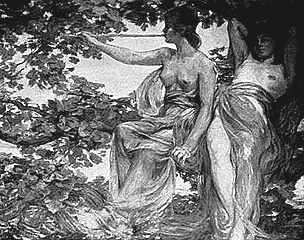
Ida J. Burgess, Dawn.
Reception Room, Illinois State
Building, 1893 Exposition.
More information on Alice D. Kellogg.
More information on Pauline A. Dohn.
More information on Helen B. Gregory.
More information on Marie K. Lusk.
More information on Mary W. Means.
More information on Anna Weaver Jones.
More information on Caroline D. Wade.
More information on Ida J. Burgess.
More information on Adele Fay.
![]()

Julia Bracken Wendt's sketches for six women's sculptures

Maternity--by
Ellen Rankin Copp
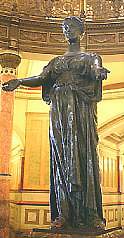
Illinois Welcoming
the Nations of the
World by Julia
Bracken Wendt
These six commissioned statues were supposed to be eight-feet tall and represent the "mental virtues" or typical "attributes of women" as realized by six different women sculptors. The six statues and their sculptors were as follows (left to right): "Maternity" by Ellen Rankin Copp; "Justice" by Janet Scudder; "Charity" by Caroline S. Brooks; "Faith" by Julia Bracken Wendt; "Learning" by Zulime Taft; and "Art" by Bessie Potter Vonnoh. (Note: Zulime was the sister of head sculptor Larado Taft.) It is unclear where these statues were finally placed. The original plan seems to have been setting them up in the main exhibit gallery between the six-foot tall windows, but a later reference seems to indicate they were displayed in the Women's Reception Room of the Illinois State Building.
Julia Bracken Wendt was also commissioned to produce a seventh statue--Illinois Welcoming the Nations of the World--which was positioned at the door of the women's exhibition room in the Illinois State Building to welcome the visitors. It now resides in the Illinois State Capitol. She was responsible for the "flying figures" on the corners of the Woman's Building and also played a major role, as a "white rabbit" working under Larado Taft, in creating the entryway Flora statuary to the Horticultural Building. See Horticultural Building statuary.
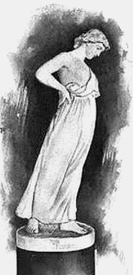
A Nymph--
commissioned statue
by Janet Scudder.

Education
--commissioned
statue by Frances M.
Goodwin.
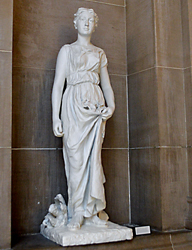
Indiana--commissioned
statue by Retta T. Matthews.
For more information, see Frances M. Goodwin, Retta T. Matthews, and Janet Scudder.

Forward--commissioned statue
by Jane Pond Miner.
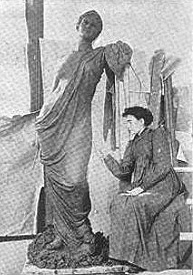
Genius of
Wisconsin--
commissioned statue
by Helen Farnsworth Mears.
For more information, see Jane Pond Miner and Helen Farnsworth Mears.
![]()
![]()
Go to Women's Public Arts & Architecture: Outdoor Statuary, p. 3
Return to Women Public Arts & Architecture: Woman's Building, p. 1
Return to Site Index
![]()
![]()
Text written by K. L. Nichols
Painting, top of page: Frances C. Jones,
Eastern Veranda of the Woman's Building Looking
toward
the Illinois Building, World's Columbian Exposition (1893)
Return to Nichols Home Page
Suggestions/Comments: knichols11@cox.net
Posted: 6-25-02; Updated: 5-1-20